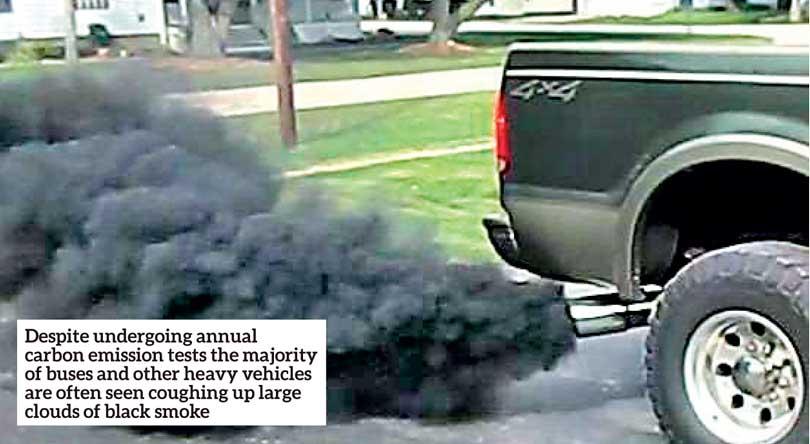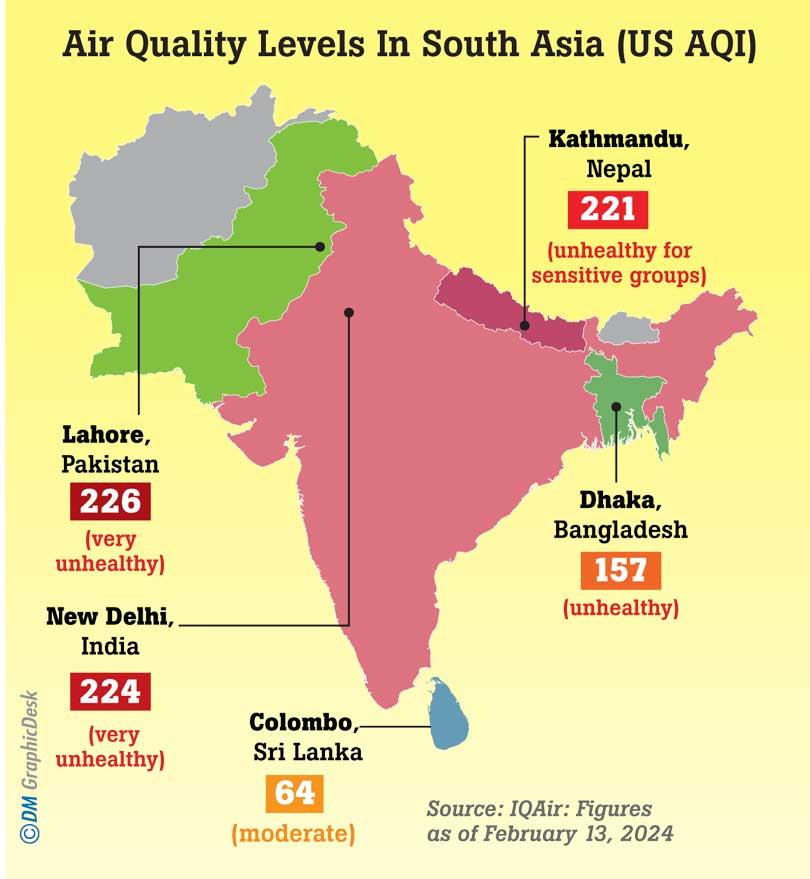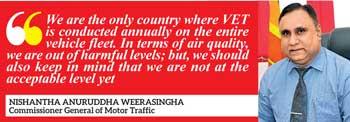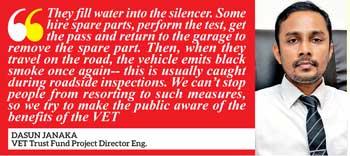15 Feb 2024 - {{hitsCtrl.values.hits}}


 Sri Lankans breathe the least polluted air compared to most South Asian countries, according to IQAir’s 2022 World Air Quality Report. However, the air quality levels of the island are still not at recommended levels– and vehicular emissions are a major contributor to this condition. With measures such as annual Vehicular Emission Tests (VET) and roadside tests introduced to manage this issue, one could wonder why some vehicles continue to emit black smoke. One reason for this is the ‘outdated’ VET programme that is still being conducted. This programme is however slated to end in 2027 with the introduction of the Roadworthiness Test conducted by the Department of Motor Traffic (DMT).
Sri Lankans breathe the least polluted air compared to most South Asian countries, according to IQAir’s 2022 World Air Quality Report. However, the air quality levels of the island are still not at recommended levels– and vehicular emissions are a major contributor to this condition. With measures such as annual Vehicular Emission Tests (VET) and roadside tests introduced to manage this issue, one could wonder why some vehicles continue to emit black smoke. One reason for this is the ‘outdated’ VET programme that is still being conducted. This programme is however slated to end in 2027 with the introduction of the Roadworthiness Test conducted by the Department of Motor Traffic (DMT).
Vehicular emissions and air quality
 According to the Air Quality Index provided by the National Building Research Organization (NBRO), the air quality of Colombo district fluctuates between ‘moderate’, ‘unhealthy for sensitive groups’ and ‘unhealthy’ throughout the day. Two studies conducted in the 1990s found that vehicular emissions were a major contributor to air pollution in Sri Lanka. A study conducted by the Ministry of Health in the 1990s also found higher levels of lead– which was a component of automobile fuel– in the blood of a sample of traffic police officers and schoolchildren in Colombo.
According to the Air Quality Index provided by the National Building Research Organization (NBRO), the air quality of Colombo district fluctuates between ‘moderate’, ‘unhealthy for sensitive groups’ and ‘unhealthy’ throughout the day. Two studies conducted in the 1990s found that vehicular emissions were a major contributor to air pollution in Sri Lanka. A study conducted by the Ministry of Health in the 1990s also found higher levels of lead– which was a component of automobile fuel– in the blood of a sample of traffic police officers and schoolchildren in Colombo.
Since then, the Ministry of Environment has gazetted the regulation on vehicle emission, fuel quality and vehicle importer specifications. In response to the management of vehicular emissions, the VET programme also commenced in the Western Province and expanded throughout the island by 2013. Furthermore, the Central Environmental Authority (CEA) set up 3 ambient air quality monitoring stations to monitor and promote air quality standards and emission control measures on the island.
According to the Commissioner General of Motor Traffic Nishantha Anuruddha Weerasingha, the ambient air quality levels (the quality of outdoor air in the surrounding environment) in Sri  Lanka at present are not at harmful levels owing to the VET.
Lanka at present are not at harmful levels owing to the VET.
“Although it is not perfect, when compared with the South Asian region, we are in a better place in terms of the VET. We are the only country where VET is conducted annually on the entire vehicle fleet. In terms of air quality, we are out of harmful levels; but, we should also keep in mind that we are not at the acceptable level yet.”
One major hindrance to the issue of vehicular emissions is the aged vehicle fleet. “Due to the economic state of the country, people use the same vehicle throughout their lives, so a lot of new vehicles aren’t added to the fleet. We are not in a position to remove all old vehicles. So, we are managing the situation in the best way possible and moving forward,” Weerasingha observed.
According to the VET Trust Fund Project Director Eng. Dasun Janaka, another reason for black smoke emission is due to vehicle users cheating on the VET. “Some people resort to various methods to obtain a pass on the VET certificate. They fill water into the silencer. Some hire spare parts, perform the test, get the pass and return to the garage to remove the spare part. Then, when they travel on the road, the vehicle emits black smoke once again-- this is usually caught during roadside inspections. We can’t stop people from resorting to such measures, so we try to make the public aware of the benefits of the VET. Through awareness programmes, we inform them that by passing the emission test their fuel efficiency can be improved by 20-30%,” Janaka noted.
Additionally, with more users delaying the servicing of their vehicles due to the high costs, there is an increase in the emission of black smoke. “The trend of black smoke emission is increasing because prices of spare parts, oil, and other consumables have increased due to inflation. This has led people to postpone servicing their vehicles. For instance, a person who services within 5000 RPM, does it at 6000 RPM now. There is an increase in black smoke especially in diesel vehicles,” Janaka further observed.
Roadworthiness Test
Despite undergoing frequent roadside emission tests in addition to the annual VET, the majority of buses and other heavy vehicles are often seen coughing up large clouds of black smoke. This is because, with the type of VET that is conducted at present, vehicles are tested when they are immobile; hence, the test does not reflect the load on the engine while vehicles are travelling on the road. However, this issue can be rectified with the introduction of the Roadworthiness Test in 2027.
Janaka expanded on the need for the Road Worthiness Test. “There are two types of emission tests. One is the ‘Loaded’ test and the other is the ‘No-load’ test. Most buses are seen emitting black smoke because they are tested in the ‘No-load’ condition. The No-load test is simple and can be completed within five minutes. The infrastructure cost is also lesser as it only needs a tailpipe machine. The technical know-how is also lesser than the other test. However, since the bus is tested when the handbrake is applied and is immobile, the engine doesn’t receive a load. The issue then is that the result obtained isn’t the same as when the bus is travelling on the road. With a bus full of passengers, high tire pressure and road conditions, the black smoke emission is greater,” explained Janaka.
According to Janaka, a device known as the chassis dynamometer will be required to perform the Loaded Test as part of the Roadworthiness Test. “Loaded tests will be costly. The technical know-how is also higher. Since our vehicle fleet is also aged, this test has the potential to cause damage to these vehicles. This is ideal for newer vehicles. This is one reason why we have been implementing the No-load test in Sri Lanka,” he said.
He also stated that with the Roadworthiness Test, in addition to the emission tests, tests on brakes and tyres can also be conducted and will help prevent accidents. “We will be commencing studies on this within the year. Hopefully, procurement will commence by the end of 2025,” said Janaka.
New initiatives by DMT in the pipeline
While the DMT developed a National Vocational Qualification (NVQ) programme for VET technicians last year, they are also in the process of introducing a Garage Training Technician programme. This programme will allow vehicle owners who fail the VET to rectify the issue at an accredited service station.
“When a vehicle fails the VET, the technician should have a better understanding of how to rectify the issue. As the first stage of this programme, we will be developing a database to determine the training gap to train technicians free of charge and give them an accreditation certificate that will be displayed at every vehicular emission centre. This will enable people to know the accredited service stations where they can rectify the issue. We have begun the data collecting process for the Western Province. This is still in the development phase. Perhaps, we can move to the physical stage in the 3rd quarter. With a limited staff we cannot do much,” he added.
With its responsibility towards reducing environmental harm and improving air quality, the VET Trust Fund has signed an agreement to implement a National Ambient Air Quality Monitoring Network, which would provide more accurate readings of the ambient air quality on the island.
Elaborating on the initiative, Janaka stated, “This is a Rs. 120 million project that will span over two years. The fact is that the air quality in one district will be different across various regions within the same district. A single user may have an air quality sensor that none other can access; so we will be developing a platform where they can connect their data to our system and we can visualise it in our platform. We are aware that the NBRO has a total of about 20 such sensors, while some universities and industries also have air quality sensors. But these are not available on a single platform. Therefore, we are developing a platform where any data source can provide their input to the platform. When someone accesses this platform, the individual can obtain a real-time picture of ambient air quality in any region. More sensors can give accurate readings and a better understanding of the real picture,” he said. Janaka added that at present there are three ambient air quality monitoring stations which are fully funded by the Trust Fund. A total of Rs. 30 million was disbursed to the CEA, NBRO and Ministry of Environment as operation and maintenance costs last year. “We have only three scientific level ambient air quality monitoring stations– in Battaramulla, Kandy and another mobile station belonging to the NBRO. These have been purchased from the Trust Fund. We provide for the operational and maintenance costs annually,” he said.
Proper monitoring would help control and regulate air pollution and maintain the air quality at least up to the regulated standards.
WhatsApp Spotter Programme
In March 2023, the DMT issued a WhatsApp number, 0703500525, urging the public to report vehicles that emitted black smoke. The public was requested to share photographs or videos of such vehicles with visible licence plate numbers, also mentioning the location and time of spotting the vehicle. The DMT warned that vehicle owners who failed to comply and rectify the issues will have their revenue licences blacklisted.
This new initiative was brought forward to help reduce air pollution in the country and also allowed the project office to keep checks on vehicles while functioning with a limited staff.
Since March 2023, nearly 2,100 complaints have been received via WhatsApp and only 259 revenue licences have been blacklisted.
“We are satisfied with the number of complaints we received this year, but our target is to increase the figure to 10,000 complaints a year. From time to time we remind people to report vehicles emitting black smoke to our Whatsapp number,” he said.
Constraints in implementation
The main constraint is the likely dissolution of the Trust Fund which could hinder the implementation of future projects. With discussions into the dissolution taking place since 2018, the majority of the staffers in the project office have resigned.
The VET Trust Fund was established in 2008 with a Project office that was in charge of centre auditing, on-road testing, complaint management, and awareness campaigns. The main purpose of the Trust Fund is to facilitate the VET program without drawing funds from the Treasury. Emission testing companies transfer an amount equivalent to 10% of the test fee to the VET fund. The VET fund is responsible for covering all government expenses associated with the implementation of the VET program.
“We don’t have sufficient manpower. We have only ten staff in our project office who have to carry out roadside checks, manage WhatsApp complaints and oversee the VET programme among other tasks. This is why we implemented the WhatsApp programme last year encouraging the public to be involved with reporting of vehicles emitting black smoke. There are Development Officers attached to the District Secretariat offices who specialise as Environmental Officers attached to the Ministry of Environment. With the support of the Ministry of Environment, we have gotten them involved in our program.”
Speaking of the option of recruiting volunteers, Janaka stated, “We recruit volunteers from campuses, but as a regulatory body we are unable to depend on them.”
04 Jan 2025 3 hours ago
04 Jan 2025 4 hours ago
04 Jan 2025 5 hours ago
04 Jan 2025 5 hours ago
04 Jan 2025 5 hours ago